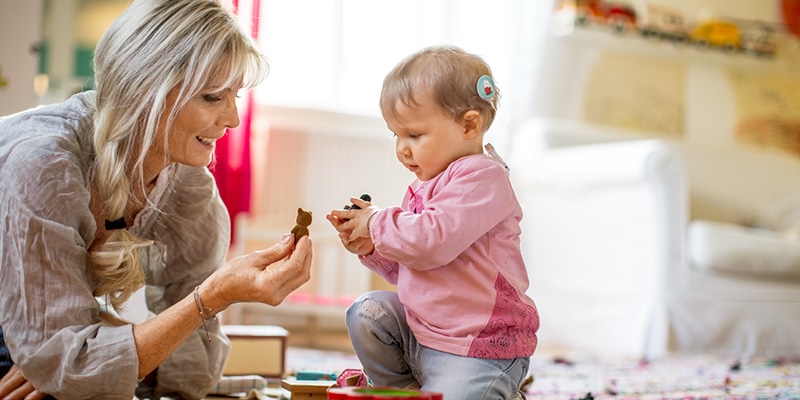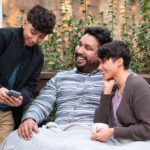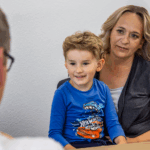MED-EL
Published Jun 08, 2022
MED-EL Lesson Kit for Babies 2

Early enrollment in family-centered intervention contributes to positive outcomes in language development for infants with hearing loss.Moeller, M. (2000). Early Intervention and Language Development in Children Who Are Deaf and Hard of Hearing. Pediatrics, 106(3), e43. https://doi.org/10.1542/peds.106.3.e43[1],Yoshinaga-Itano, C. (2003). From Screening to Early Identification and Intervention: Discovering Predictors to Successful Outcomes for Children With Significant Hearing Loss. Journal of deaf studies and deaf education, 8(1), 11–30. https://doi.org/10.1093/deafed/8.1.11[2] However, a lack of resources in various health services and regions means that not all families begin benefiting from rehabilitation services after the diagnosis of their child’s hearing loss.
Group cochlear implant rehabilitation support for babies and their families may offer a time and resource-efficient alternative for the early months. Time and cost efficiency is not the only benefit though. Caregivers of children with hearing loss have described that making connections and communicating with other parents of children with hearing loss facilitated their coping and parenting experience.Zaidman-Zait, A. (2007). Parenting a Child With a Cochlear Implant: A Critical Incident Study. Journal of Deaf Studies and Deaf Education, 12(2). https://doi.org/10.1093/deafed/enl032[3]
Benefits of Group Cochlear Implant Rehabilitation for Babies & Families
Caregivers reported that opportunities to share, face challenges, and problem-solve with other parents reduced anxiety levels and worries.Zaidman-Zait, A. (2007). Parenting a Child With a Cochlear Implant: A Critical Incident Study. Journal of Deaf Studies and Deaf Education, 12(2). https://doi.org/10.1093/deafed/enl032[3] In addition, group support “contributed to their sense of belonging, which also reduced their sense of loneliness and normalized the experience of parents and children dealing with deafness”.Zaidman-Zait, A. (2007). Parenting a Child With a Cochlear Implant: A Critical Incident Study. Journal of Deaf Studies and Deaf Education, 12(2). https://doi.org/10.1093/deafed/enl032[3] Zaidman-Zait makes a strong case for group cochlear implant rehabilitation support for babies and their families.
This is why our Lesson Kits for Babies also include group lesson plans to support professionals to provide group therapy intervention to this population.
Cochlear Implant Rehabilitation for Babies
The MED-EL Lesson Kits for Babies were developed to support rehabilitation professionals to provide early intervention to young children and babies with hearing implants. They are also designed to help professionals provide guidance and coaching to families and caregivers. With this resource, we hope to offer professionals practical materials to support this population.
Each kit includes:
- Two lesson plans and a group lesson plan with suggestions for goals and activities
- Guidance for families to promote early communication and listening skills in their child
- Detailed instructions for practical activities to carry out in therapy sessions
- Printable resources for hearing implant intervention to supplement therapy activities based on routines and play
The first MED-EL Lesson Kit for Babies is based on the theme of Routines. The second lesson kit is all about having a Mess. The lesson kits for babies are theme based to allow caregivers to easily generalize activities and skills practiced in therapy sessions to the home environment, meaning more carryover and utilization of strategies.
Lesson Kit for Babies 2
The activities in Lesson Kit for Babies 2 include playdough, painting, and cleaning up. There is also a storybook, ‘Mouse Makes a Mess’, which is written and illustrated especially to target the goals of listening and spoken communication in young children with hearing implants. Therapist notes explaining how to complete the activities and engage caregivers are provided.
For more information on how to use it, access the Lesson Kits for Babies video tutorial on the MED-EL Academy after logging into your myMED-EL account.
Don’t forget to share this with your colleagues or friends who might also enjoy this material.
References
-
[1]
Moeller, M. (2000). Early Intervention and Language Development in Children Who Are Deaf and Hard of Hearing. Pediatrics, 106(3), e43. https://doi.org/10.1542/peds.106.3.e43
-
[2]
Yoshinaga-Itano, C. (2003). From Screening to Early Identification and Intervention: Discovering Predictors to Successful Outcomes for Children With Significant Hearing Loss. Journal of deaf studies and deaf education, 8(1), 11–30. https://doi.org/10.1093/deafed/8.1.11
-
[3]
Zaidman-Zait, A. (2007). Parenting a Child With a Cochlear Implant: A Critical Incident Study. Journal of Deaf Studies and Deaf Education, 12(2). https://doi.org/10.1093/deafed/enl032
References
MED-EL
Was this article helpful?
Thanks for your feedback.
Sign up for newsletter below for more.
Thanks for your feedback.
Please leave your message below.
CTA Form Success Message
Send us a message
Field is required
John Doe
Field is required
name@mail.com
Field is required
What do you think?
The content on this website is for general informational purposes only and should not be taken as medical advice. Please contact your doctor or hearing specialist to learn what type of hearing solution is suitable for your specific needs. Not all products, features, or indications shown are approved in all countries.
MED-EL



